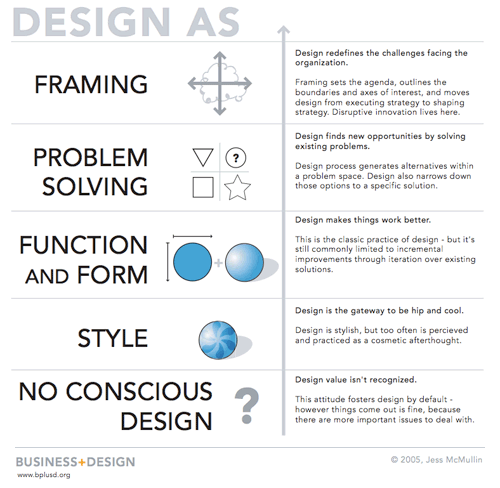In our Influencing Strategy by Design workshop, Tom Chi and I outline several tips for presenting to executives or senior leadership within an organization. Here’s a few of my favorites:
Enthusiasm Matters
Most presentations in large organizations are stagnant and dull affairs and do nothing to showcase any genuine interest the presenter may have in the subject matter. Enthusiasm in a presentation is often a reflection of the level of engagement people will later bring to actual product work. If your presentation lacks excitement, would your passion for delivering on the promises in your presentation fall equally short?
Tell a Story
When preparing an executive presentation it’s quite easy to get lost in the details on each individual slide. When this happens, chances are the overall story you are trying to communicate suffers. In reality, the story that weaves your individual slides together is more powerful than the material within each slide. It’s the story you tell that executives will remember and pass along to other people in the organization. Stories inspire the imagination and make sharing information much easier and natural.
Be Ready to Improvise
The majority of executives got to where they are by being knowledgeable about the many factors that make their business work. As a result, they are likely to ask tough questions that could catch the unprepared presenter by surprise. Be ready to think on your feet by considering a wide range of potential concerns or questions and how a conversation about them could play out.
Communicate at the Right Level
While it is certainly possible to have a conversation with senior management about the stylistic aspects of a product, chances are their opinion on color isn’t the kind of information that will help you make the right strategic decisions for your product. It’s generally best to keep executive presentations at the problem framing and problem solving levels and not focused solely on discussing style or function and form. See Jess McMullin’s Design Maturity Continuum (shown below) for a useful visualization of these levels. Start at the top and if a conversation falls to far down the continuum elevate to a level that will provide meaningful strategic feedback for you and your team.
Understand the Executive Mindset
Today, most large organizations operate at global scale and across a wide range of services and products. Due to the sheer number of considerations on their plate, the executives at these companies can’t continually monitor everything. This leaves them hungry for data especially customer insights. Senior leaders also tend to be short on time. So when assembling an executive presentation think high data density with clarity.
Close the Loop
Following up an executive presentation when new data supports or refutes topics previously discussed, when a key action has been executed, or when performance data comes in helps build credibility and ongoing trust.
